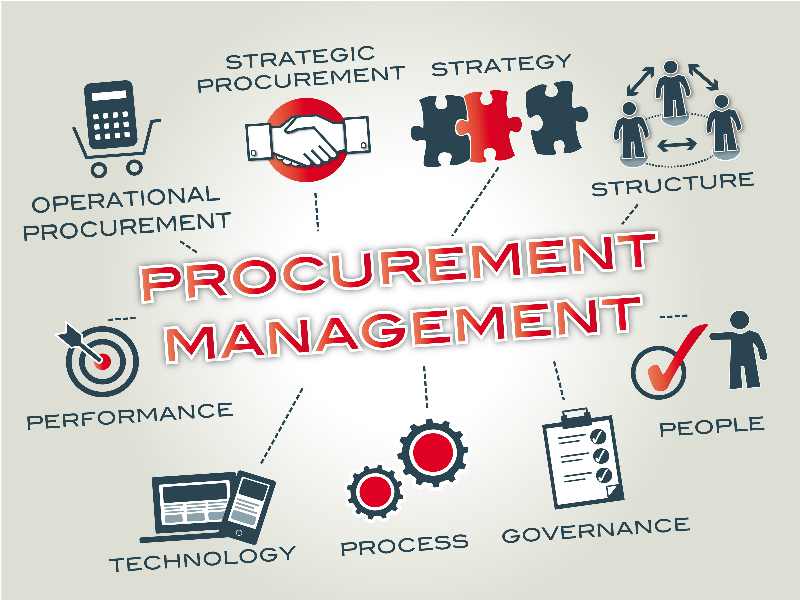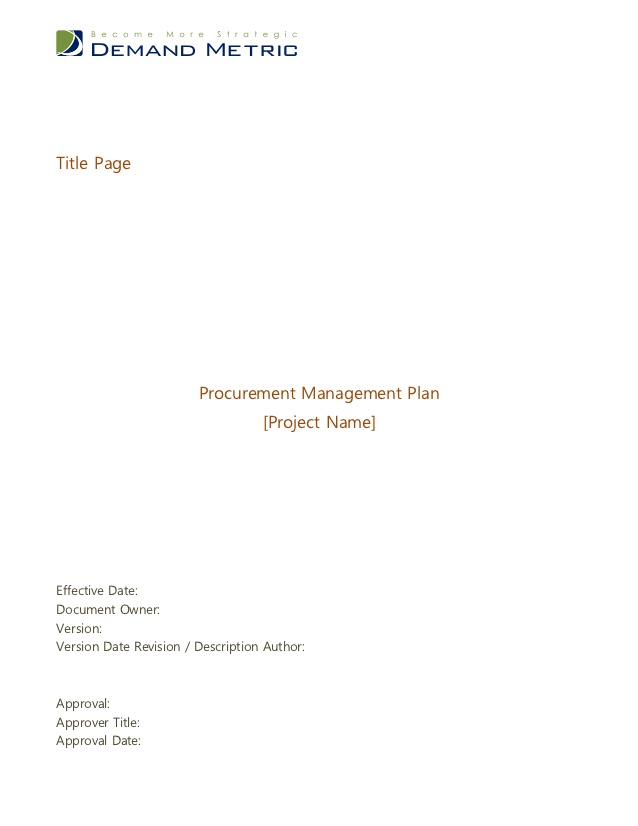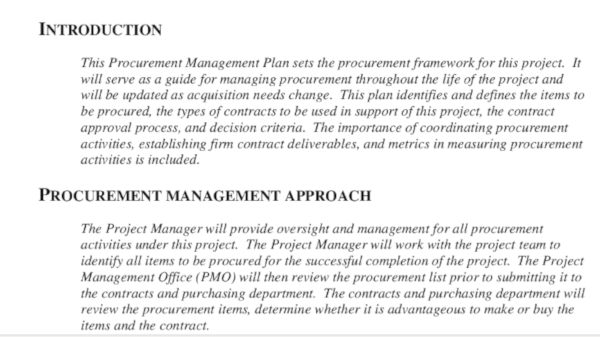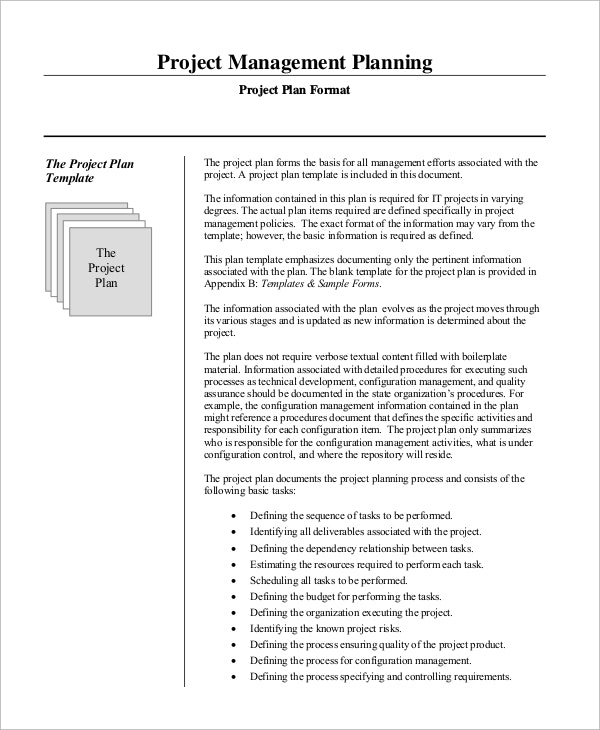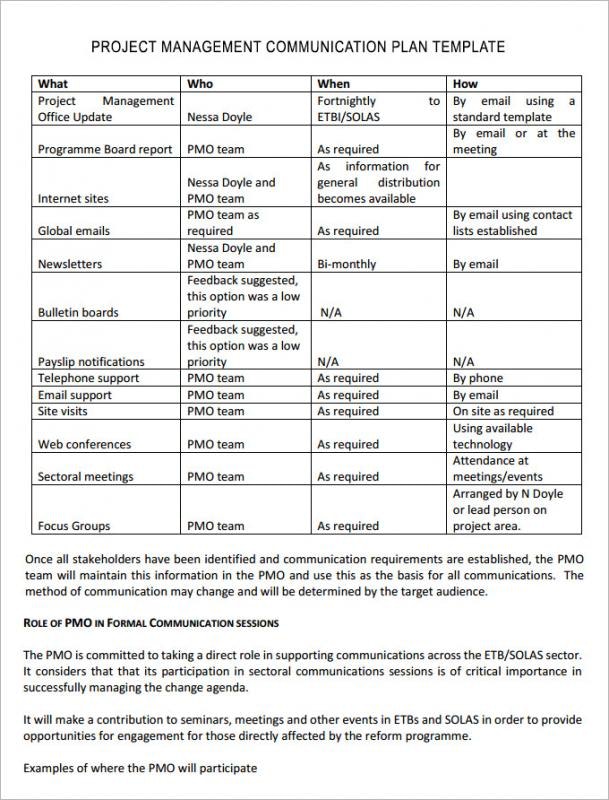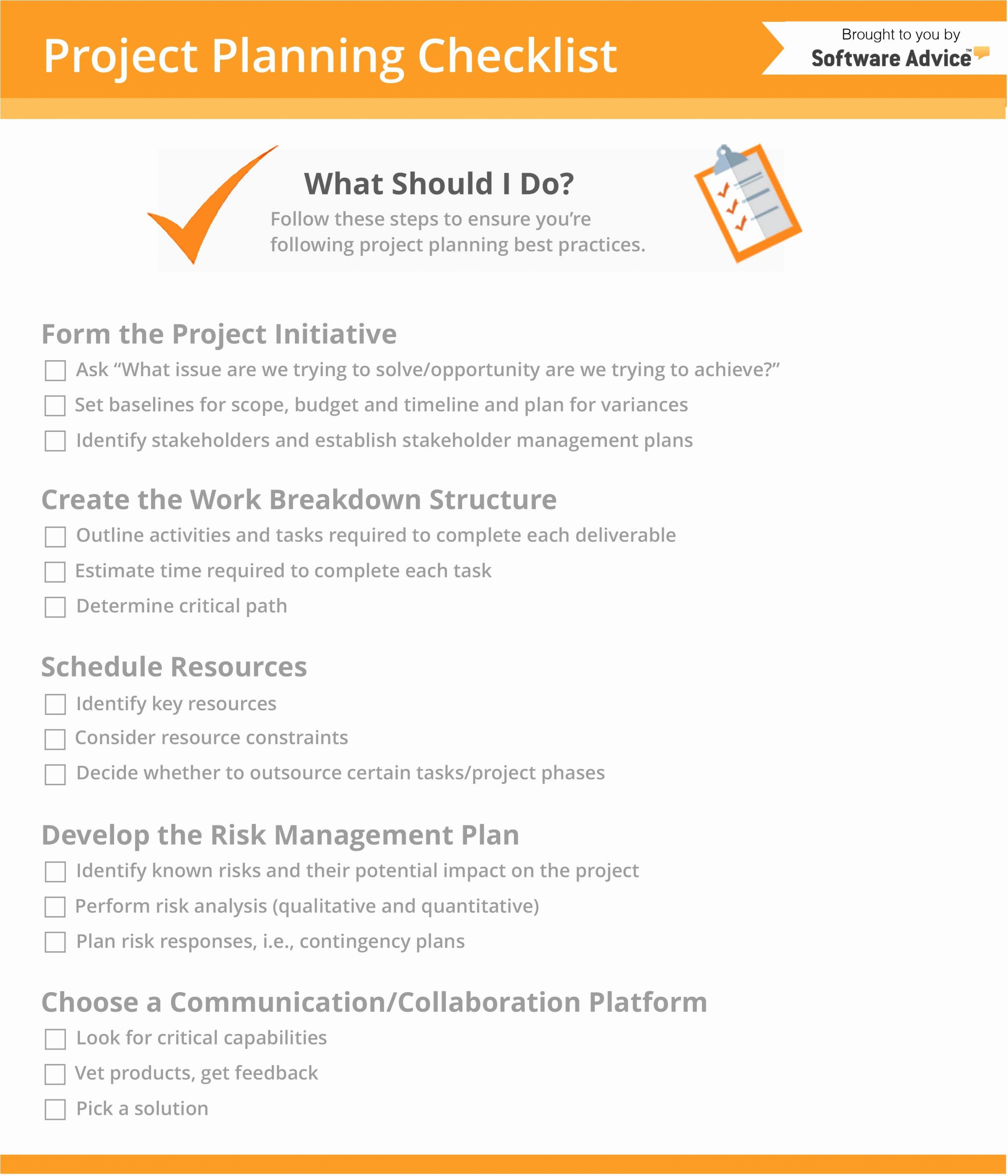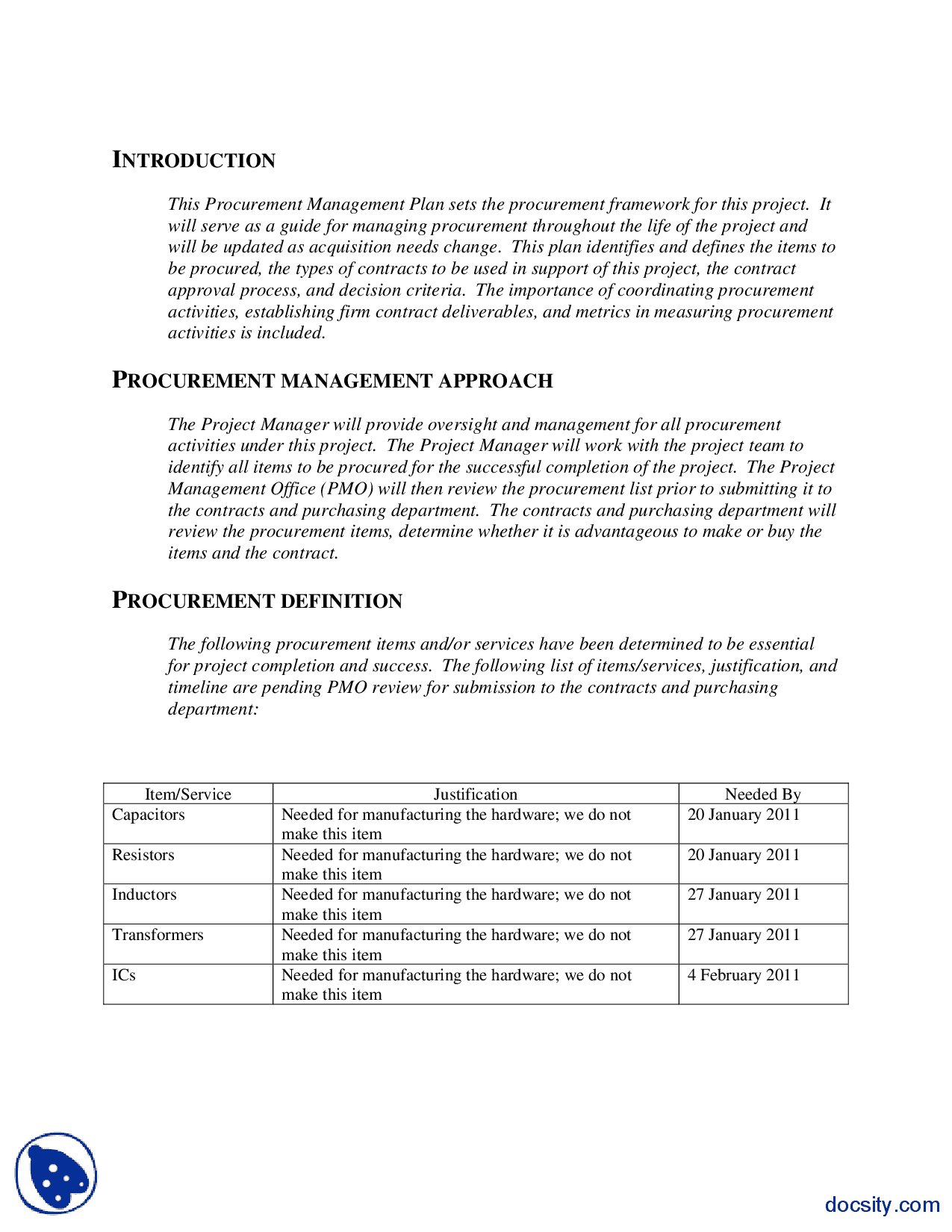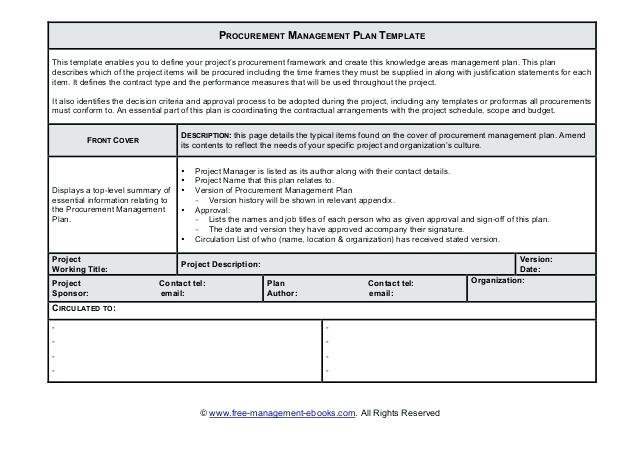10+ Procurement Management Plan Examples to Download
Procurement, by definition, is the process of acquiring materials, suppliers, or services that a company or a project needs in order to successfully operate. In connection, a procurement strategy plan would refer to the systematic approach of cost-effectively purchasing the company’s required supplies, taking into consideration a variety of elements and factors such as the timeline for procurement, the funding and the budget, and the projected risks and opportunities. You may also see management plan examples.
Before you can develop an effective procurement strategy, it is important for you to first sit down and assess the details that you have to work with, such as the project’s objectives, the available and existing resources and supplies at your disposal, and the budget and project timeline. By assessing these elements, the team will be able to start planning for an effective procurement strategy plan that would be specially designed according to the goals of the project. You may also check out here performance management plan examples.
Procurement Management Plan Example
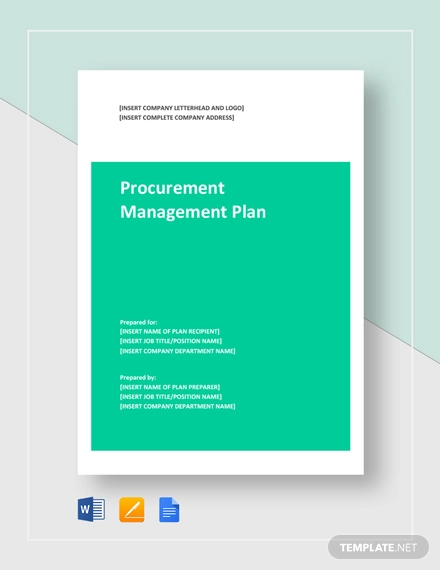
Procurement Management Plan Template
The Procurement Management Plan
The purpose of a project procurement management plan is to successfully establish and maintain relationships with vendors of goods and services during the project life cycle, which is an essential part of every project management chain process. It is concerned with overseeing designated sets of temporary operations. Project management for procurement is usually divided into four major processes: planning, selection, administering, and closing procurements. You may also see quality management plan examples.
The Planning Process
The first part of the process involves planning. Here is where the creation of the official procurement management plan will start. The decisions made will involve which items will be internally procured and which items will be externally outsourced. This information will heavily impact the project’s budget and financial scope.
Sample procurement documents will be prepared and criteria framework will be developed to create a selection of potential vendors who can answer to the project’s needs and the company’s expectations. This selection matrix will be based on the project’s scope, schedule, and requirements, while also taking into consideration risk factors and budgetary constraints. You may also check out here communication management plan examples.
The Selection Process
The selection process will involve comparing and contrasting the vendors among each other to understand the advantages, disadvantages, and contractual offerings of each one to see who should be chosen for the project. Standard tools and techniques are used to select procurements, such as video conferences with bidders that will allow for the understanding of the project requirements and for asking questions.
Procurement contracts are decided and awarded through collaborations between various managers. Resource calendars will then be created with details on when, where, and how the resources will be used and managed. The corresponding project management plan will be adjusted according to resource calendar updates.
All of the proposals from the competing vendors will be carefully evaluated. However, if there are no satisfactory bids available, the procurement management team may feel the need to utilize online advertisements and other tools in order to solicit new bidders.
The Administration Process
The third major step, which is the administration process, refers to the tools and processes that will be used to manage the developing relationship with the vendors. The administration phase will result in the continued creation of procurement documents and spreadsheets that may help drive project changes.
A centralized system of contract change monitoring and control will be used to evaluate and determine whether potential changes to contracts are needed. There are formal physical inspections, internal audits, and reviews of procurement operations in order to generate synthesized performance reports that provide real-time feedback. The administration process is extremely important, which is why it’s usually managed through a supply chain or a project management process. You may also see change management plan with examples.
The Closing Process
The closing process will involve more than simply ending the procurement process by accepting proposals and signing contracts. It’s also about looking at weaknesses, documenting successful processes, and summarizing the project for future needs. Some companies even prefer to conduct simple audits using a performance matrix in order to grade the overall project.
Documentation is of utmost importance to be used for reference for future projects, which may already involve different teams in new locations. During the closing process, negotiations may be necessary to resolve contract disputes. Ideally, potential issues will be noted during the administration process in order to begin the mediation process early on. You may also check out here scope management plan examples.
When it comes to project procurement management, there are certain standards and functions. For example, most companies would prefer to use a smaller number of suppliers with long-term relationships instead of opting for a group of suppliers to outbid each other for the lowest price.
Establishing and nurturing relationships with suppliers is important because this can open opportunities for supply chain partners and shareholders to work closely together on improvement and coordination activities.
Procurement Management Plan Cover Page Example
Procurement Management Plan Document Example
Project Management Planning
Four Steps in Designing a Procurement Management Plan
When you are working on a project, it’s not uncommon for you to need certain materials or services in order to successfully execute the tasks necessary for the project’s completion. But, of course, you can’t simply purchase resources as the need arises for them. There is a budget and a timeline you need to consider.
To make sure that you don’t spend too much project money just to purchase the materials you need, and to make sure that the project will be delivered on time, you will need to develop a plan for fulfilling those needs. Your best option is to use a systematic process for developing a procurement plan that can easily be transferred to a simple project management software. You may also see data management plan examples.
Step #1: Decide what to procure.
Often, the decision about which materials you need to procure is made for you. For example, you need a product or service in order to finish a job, and you simply do not have the assistance for it in-house. All you need to do is to identify the resources you lack and look for an outsource who can provide it for you.
But there will also be times when the decision doesn’t always come clear to you. Perhaps the necessary parts that you need can be produced in-house, but at increased cost; or maybe the service can be provided by your employers, but the key personnel who is perfect for the job is on vacation, or lacks the technical knowledge necessary to get the job done.
While designing your procurement management plan, you will have to look carefully at all of these issues and decide which items or services need to be procured from outside your organization. A good plan will require more than simply stating that you need what, and expecting it to be automatically purchased for you. You may also see debt management plan examples.
While making your list, consider the justification for the procurement, the expected cost, and the deadline, and incorporate all of that information into your plan. In addition, consider alternatives to the items you don’t have on hand. In certain cases, the plan can be adjusted or additional personnel or items can be utilized to eliminate the need for procurement or to lower the costs when making it.
Step #2: Choose your vendors.
Choosing your vendors is an important part of the procurement process. You don’t just want to pick the first supplier you find, you want to make sure that their products are quality-made and that they are cost-effective. Think of these materials and supplies as your investment. Naturally, you would want to put your money, not to mention your trust, where you can get something out of it in the long run. You may also see effective classroom management plan examples.
Many organizations choose vendors with whom they have an existing relationship with. A good experience with a supplier is a perfectly reasonable excuse for collaborating with them again. Sometimes, though, companies choose vendors who offer the lowest prices without actually making sure that the vendor meets the needs of their project.
Whatever your reason is for choosing your vendor, the most important thing is that it will help you achieve your end product. Once you have a comprehensive list of what needs to be procured, begin the vendor selection process. Although price and costs will always be a top concern, you also need to consider whether the vendor can deliver the product or service within the required time frame, whether they can give your quality, and whether their cost and reputation are in line with your needs.
In some cases, you may find that the vendor offering the lowest price can’t meet your deadline, or they may be offering a product that doesn’t meet your quality standards. Which is why you need to be smart in choosing. If you can’t get all that you are looking for from one vendor, make sure you arrive at a deal that will not hold you at a disadvantage, especially money-wise. You may also see behaviour management plan examples.
When you have selected a vendor, it’s important that the project manager, or his representative, stays in contact with the vendor and ensure that the product or service is on track for the agreed upon delivery date. It is a part of the procurement process for this responsibility to be assigned to someone trustworthy, who will also develop contingency plans should something go awry.
Step #3: Assign roles and responsibilities.
Beyond determining who will manage the relationship with vendors, it’s important to determine other team members’ roles and responsibilities within the procurement process. For example, one team member may be responsible for working with an outside contractor to manage the workflow or for researching potential vendors for a part or service that has never been procured before. The procurement plan must specifically outline these responsibilities, including deadlines. You may also see risk management plan examples.
Step #4: Layout contract requirements.
Once you have settled all the materials that you need and the people responsible for procuring them, the finals step is to lay out the contract requirements for the vendors. These requirements may be determined by the company’s policy, especially in terms of payment and invoicing.
In any case, the contract requirements section of the procurement plan should outline which contracts are to be used and any other important information required for managing the procurement process.
Developing a procurement plan early in the project management process is a vital step in ensuring that your project proceeds in a timely manner and that there will be no unpleasant surprises along the way. While no plan is entirely foolproof and accidents are bound to happen, taking steps to account for and address those circumstances ahead of time keeps everyone on the same page and increases the likelihood of a successful project. You may also see emergency management plan examples.
Project Management Planning Format
Project Management Communication Plan Template
Project Planning Management Checklist
The Benefits of Effective Procurement Planning
Procurement planning is a process whereby procurement practitioners sketch out in advance an arrangement which diagram a plan as to what, which, when, and how purchases are to be conducted in a given period. This plan considers what is to be procured, which methods of procurement to be used based on regulated thresholds, and when and how the processing steps will be conducted. You may also see cost management plan examples.
Effective procurement planning is essential for all procuring entities in the implementation of the purchasing objective for the following reasons:
- An effective plan can help you save money.
- An effective plan serves as a conduit to achieving the company’s objectives.
- An effective plan ensures compliance with regulatory policies.
- An effective plan provides a framework to guide procurement officers in the achievement of their tasks and duties.
When procurement practitioners outline their procurement activities prior to the beginning of a fiscal year, this process provides an organized means whereby time and money are saved. This happens when timelines are followed in the procurement of contract packages and when patience is exercised in the use of the right procedures enshrined by law to ensure transparency and competitiveness.
Imagine conducting the process of procurement in a hasty manner disregarding the processing steps required and ended up with items that are undesirable, unreliable, nondurable, and costly. This would result in a massive loss of collateral, and probably even repurchase of similar items in the not so distant future to compensate for the low-quality items purchased already, thus consuming your precious time and resources. You may also see waste management plan examples.
An entity’s procurement objectives are achieved when an effective procurement plan is utilized. Each contract package procured has a direct or indirect effect on the general aims and objectives of the procuring entity. With this in mind, when a procurement plan is being prepared, practitioners must consider the impact that these purchases will have on the users of these goods, works, and services.
Project Management Plan
Procurement Management Plan Approach
Procurement Management Plan Template Sample
Conclusion
The procurement cycle begins with the identification of a need and ends with the award of a contract. A clearer understanding is gained once the goal of procurement is understood.


